Related Research Articles

Pistoia is a city and comune in the Italian region of Tuscany, the capital of a province of the same name, located about 30 kilometres (19 mi) west and north of Florence and is crossed by the Ombrone Pistoiese, a tributary of the River Arno. It is a typical Italian medieval city, and it attracts many tourists, especially in the summer. The city is famous throughout Europe for its plant nurseries.

Palazzo d'Accursio is a palace once formulated to house major administrative offices of the city of Bologna, region of Emilia-Romagna, Italy. It is located on the Piazza Maggiore, and is the city's Town Hall. The palace is also home to the Civic Art Collection, with paintings from the Middle Ages to the 19th century; the Museo Morandi, with the works by Giorgio Morandi; and the Biblioteca Salaborsa, the town libraries.

The Palazzo Comunale, also known as the Palazzo del Popolo of San Gimignano has been the seat of the civic authority in the comune since the 13th century. It is located on the Piazza del Duomo close to the Collegiate Church of the Assumption of the Blessed Virgin Mary. The building and Collegiate Church are at the heart of the medieval town, and are part of the UNESCO World Heritage Site of the "Historic Centre of San Gimignano".
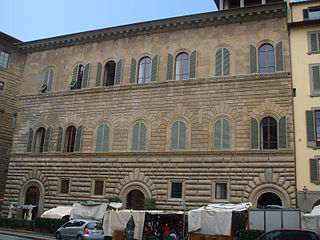
Palazzo Gondi is a palace in Florence, Italy, located a block from Piazza della Signoria. It was built in 1490 under design by Giuliano da Sangallo, who was inspired by other major works of stately buildings in the city, such as Palazzo Medici and Palazzo Strozzi. Among the elements borrowed from these earlier works are the cube-shape set around a central courtyard, the ashlar sloping on each of three floors, and the arched windows.

Palazzo Aragona Gonzaga, also known as Palazzo Negroni, is a sixteenth-century palace in Rome, Italy. It was once the residence of Cardinal Scipione Gonzaga. During that time his cousin Luigi Gonzaga also lived there, as did the poet Torquato Tasso from 1587 to 1590. In the nineteenth century it belonged to the Galitzin family, and so is also known as Palazzo Galitzin.

San Giovanni Fuoricivitas is a Romanesque religious church and adjacent buildings in Pistoia, Tuscany, central Italy. The adjective fuoricivitas refers to it location, outside of the first set of city walls, when it was founded during the era of Lombard rule in Italy.

Palazzo Gherardi is a 15th-century building in the Santa croce quarter of Florence, Tuscany, in central Italy. Its main façade is on Via Ghibellina 88, while to the right it faces Via dei Pepi.

Palazzo Panciatichi or Palazzo del Balì is a medieval aristocratic palace located on Via Camillo Benso Cavour #35 in Pistoia, Tuscany, Italy. It a block away from the Palazzo Fioravanti.
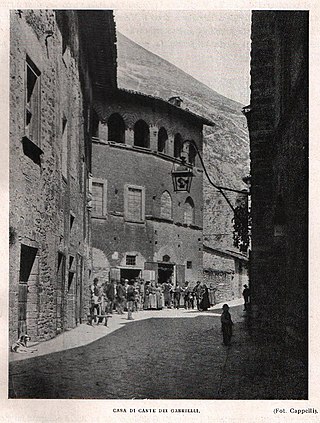
The Palazzo del Capitano del Popolo or Palazzo di Cante Gabrielli is a medieval palace in Gubbio, Italy. It is located in the San Martino's quartiere, near Porta Metauro, at the corner of via Gabrielli and via Capitano del Popolo.

Palazzo dei Convertendi is a reconstructed Renaissance palace in Rome. It originally faced the Piazza Scossacavalli, but was demolished and rebuilt along the north side of Via della Conciliazione, the wide avenue constructed between 1936 and 1950, which links St Peter's Basilica and the Vatican City to the centre of Rome. The palace is famous as the last home of the painter Raphael, who died there in 1520.

Palazzo Santa Sofia is a palace in Mdina, Malta, located in Villegaignon Street, across the square from the cathedral. Its ground floor was built in 1233, and it is believed to be the oldest surviving building in the city. The upper floor is of a much later construction, being built in the 20th century.

Palazzo Falson, formerly known as Palazzo Cumbo-Navarra, Casa dei Castelletti, and the Norman House, is a medieval townhouse in Mdina, Malta. It was purposely built as a family residence by the Maltese nobility, and it is named after the Falson family. It is presently open to the public as a house-museum with seventeen rooms of historic domestic belongings and a number of antique collections.
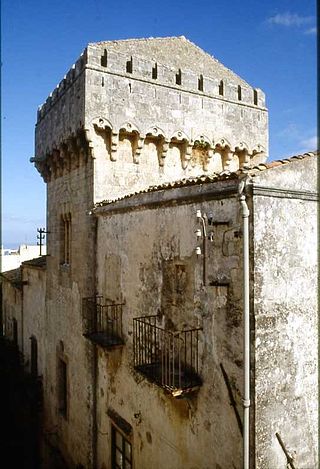
Palazzo De Ballis is a 15th-century historical building of Spanish Gothic architecture; the Tower De Ballis is a part of it. It is located in the town centre of Alcamo, in the province of Trapani.

The Fioravanti family was a noble family originating in Pistoia in Tuscany and active in Florence and other Italian towns. They were Guelf in their politics and naturally allied with the Cancellieri family and adversaries of the Ghibelline Panciatichi Panciatichi family. An early record dates to 1267, when Fioravanti d'Accorso was a member of the town council. In 1310 Ranieri, his son, was Mayor of the Pistoia. In 1319 Simone di Ranieri was a member of the elders. Giovanni di Puccio di Ranieri Fioravanti was a banker active at the court of Pope Clement V (1305-1314) in Avignon. Andrea di Simone di Baldo Fioravanti was elected Capitano della Montagna Superiore, June 17, 1354. Francesco di Rinieri was the Gonfaloniere of the Florentine Republic in the years 1385 and 1389: Neri his son was also Gonfaloniere in 1428; Fioravanti di Piero was the Cavalry Captain in Flanders in 1510 and then for Pope Alessandro VI, commissioner at Assedius of Faenza: Vincenzo di Cipriano one of the first to be elected knight of Santo Stefano, in 1576, shortly after the establishment of that military order, and later Chancellor of the Order: Fabio of Cipriano, was Cavalry Captain in the Netherlands: Alberto di Fioravanti Knight of Malta in 1590, and Commendatore in 1610: Niccolao di Fioravanti captain in the emperor Ferdinand II against the King of Sweden in 1636, and in 1643 in Tuscany for the Grand Duke against the Barberini.

Palazzo Rossotti-Chiarelli, dating back to the 18th century, is located in via Rossotti in Alcamo, in the province of Trapani. It is in via Rossotti: in the same street you can also visit the Chiesa del Santissimo Salvatore(o Badia Grande).

The Palazzo degli Anziani also known as the Palazzo del Comune, della Comunitá or del Giano is a Gothic-style stone palace located in the ancient historic center of Pistoia, Tuscany, Italy. The palace served as city hall for centuries; it still belongs to the comune and now mainly houses the Museo Civico d'Arte Antica.

The Palazzo Pretorio or Palazzo del Podestà was initially erected to house the police and justice forces and magistrates, and is located in front of the Piazza del Duomo of Pistoia, region of Tuscany, Italy. The present building, which is mainly a Neo-Gothic construction of the 19th-century, now houses the local courts of Pistoia.
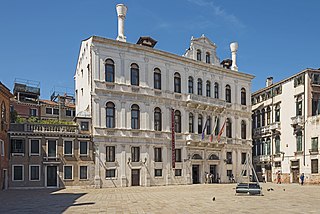
Palazzo Priuli Ruzzini Loredan, also called Palazzo Loredan at Campo Santa Maria Formosa, is a late 16th-century palace located at Campo Santa Maria Formosa in the Castello district of Venice, northern Italy, characterised by features of Renaissance and Baroque-style architecture on its façades.
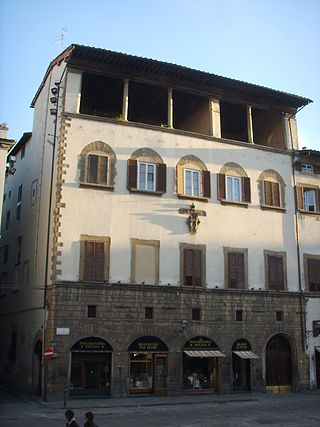
Palazzo Della Stufa or Lotteringhi Della Stufa, is in the Piazza San Lorenzo, at the corner of Via della Stufa, in Florence, Italy, in front of the Basilica di San Lorenzo.
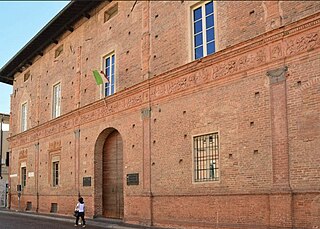
Palace Carminali Bottigella is a noble palace built by the ancient Beccaria family from Pavia. The original structure from the Sforza era was built between 1490 and 1499. The façade, which retains the original terracotta decorations, is one of the major examples of Renaissance civil building in Pavia.
References
- ↑ Tour entries for Pistoia.
- ↑ Pistoia e il suo territorio: Pescia e i suoi dintorni: guida del forestiero, by Giuseppe Tigri, Tipografia Cino, Pistoia (1853): page 221.